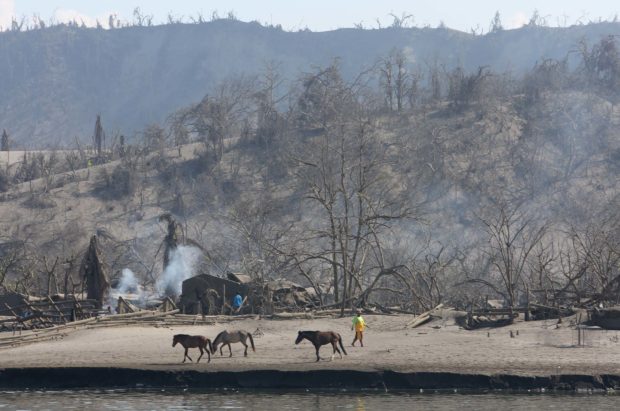
LIVING DANGEROUSLY As Taal Volcano quiets down, some residents return to Pulo (Volcano Island) to check their houses buried in ash and their horses and farm animals that survived the volcano’s steam-driven eruption on Jan. 12. —MARIANNE BERMUDEZ
IBAAN, Batangas, Philippines — While most Taal evacuees have gone home ready to resume their lives, families from Volcano Island, or Pulo are in limbo as they face a long-term, if not permanent, displacement triggered by the volcanic eruption.
The question is not only when, but where, as the national and local governments scrambled to look for resettlement sites in Batangas province to relocate close to 6,000 people.
One of the most likely locations is the 1,200-unit National Housing Authority site at Barangay Talaibon in Ibaan town, but which Mayor Joy Salvame said could accommodate only 800 households.
The Ibaan housing site, built a few years back, was intended for policemen and soldiers, but residents said only about 20 units had been occupied.
The Batangas government, over the past days, has been installing toilets, power lines and water pipes to connect empty units to a deep well.
Salvame said it might take two more weeks to furnish the units, many still lacking doors and windows.
Irene Anillo, 38, was hoping her family could settle down at least before she gives birth to her fourth child in April.
Losing everything
“There’s nothing for us to go back there (Pulo). We lost everything — the house, even the baby clothes I’ve already prepared. All these just came from donations,” she said, as she piled diaper packs to make a “room” for her family in a corner of the evacuation center.
Anillo’s was one of the hundreds of families from Barangay Alas-as in San Nicolas town, where most men worked as fishermen or caretakers of fish cages.
When tourism began to thrive in the 1980s, families raised horses to bring tourists close to the main crater.
Several farm animals were lost, too.
After the Jan.12 eruption, the government banned permanent human settlement on Pulo, which hosts communities in Sitio Tabla and Barangay San Isidro (Talisay town); Alas-as and Pulang-bato (San Nicolas); and Calawit (Balete town).
Families from Barangay Alas-as are in Ibaan’s drug rehabilitation center at Barangay Malainin, a two-building structure almost completed but never been used for its intended purpose. They are waiting for their transfer to the government housing site at Barangay Talaibon.
Ibaan was the families’ fourth stop in just three weeks after they were transferred from one evacuation center, one town after another, during the time the volcano was still erratic.
The rest of Pulo dwellers were scattered in various evacuation centers.
“We’re fine. We have water and electricity here. But it’s hard to sleep around many people in a single room,” said Pablo Basilio, 58, who not only lost his home but four cows as well.
Right now, evacuees survive on relief goods, but Basilio worries once supplies stop. Thinking about their future makes him long for his life on Pulo.
Looking for land
“It’s different on the island. If you wanted fish, you get it fresh from the [Taal] lake, if you wanted meat, we had chickens. The only thing we bought [from the mainland] was rice,” he said.
The Ibaan housing site will only be a “temporary” resettlement area. Batangas provincial administrator Levi Dimaunahan on Monday said they were scheduled this week to look for properties to buy in the towns of Balete, Malvar, San Luis and in Lipa City.
NEW COMMUNITY A government housing project in Ibaan town, Batangas province, will become the temporary home of thousands of families who used to live on Taal Volcano Island. The National Housing Authority built these houses between 2016 and 2017 for policemen and soldiers. —MARIANNE BERMUDEZ
He said these sites were outside the 14-kilometer radius danger zone but still “close” to the lake and volcano on which the settlers depend for livelihood.
“We can’t afford to do an ‘atras-abante’ anymore¬ — for the people to pull back when there’s another eruption and return once [the volcano is calm again],”Dimaunahan said. “We owe it to the next generation to fix this [issue].”